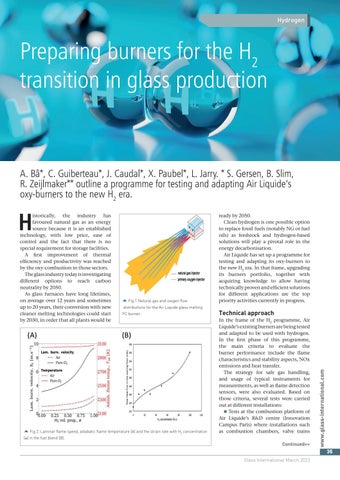Hydrogen
Preparing burners for the H2 transition in glass production
A. Bâ*, C. Guiberteau*, J. Caudal*, X. Paubel*, L. Jarry. * S. Gersen, B. Slim, R. Zeijlmaker** outline a programme for testing and adapting Air Liquide’s oxy-burners to the new H2 era.
� Fig 1.Natural gas and oxygen flow distributions for the Air Liquide glass melting FC burner.
� Fig 2. Laminar flame speed, adiabatic flame temperature (A) and the strain rate with H2 concentration
ready by 2050. Clean hydrogen is one possible option to replace fossil fuels (notably NG or fuel oils) as feedstock and hydrogen-based solutions will play a pivotal role in the energy decarbonisation. Air Liquide has set up a programme for testing and adapting its oxy-burners to the new H2 era. In that frame, upgrading its burners portfolio, together with acquiring knowledge to allow having technically proven and efficient solutions for different applications are the top priority activities currently in progress.
Technical approach In the frame of the H2 programme, Air Liquide’s existing burners are being tested and adapted to be used with hydrogen. In the first phase of this programme, the main criteria to evaluate the burner performance include the flame characteristics and stability aspects, NOx emissions and heat transfer. The strategy for safe gas handling, and usage of typical instruments for measurements, as well as flame detection sensors, were also evaluated. Based on those criteria, several tests were carried out at different installations: � Tests at the combustion platform of Air Liquide’s R&D centre (Innovation Campus Paris) where installations such as combustion chambers, valve trains
(α) in the fuel blend (B).
Continued>>
www.glass-international.com
H
istorically, the industry has favoured natural gas as an energy source because it is an established technology, with low price, ease of control and the fact that there is no special requirement for storage facilities. A first improvement of thermal efficiency and productivity was reached by the oxy-combustion in those sectors. The glass industry today is investigating different options to reach carbon neutrality by 2050. As glass furnaces have long lifetimes, on average over 12 years and sometimes up to 20 years, their conversion with new cleaner melting technologies could start by 2030, in order that all plants would be
35 Glass International March 2022
Air Liquide.indd 1
28/03/2022 11:13:14














